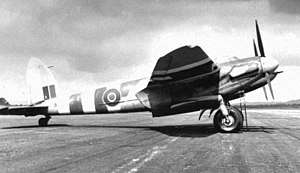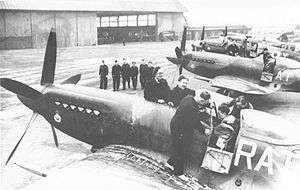No. 613 Squadron RAF
No. 613 (City of Manchester) Squadron was an Auxiliary Air Force later Royal Auxiliary Air Force squadron formed on 1 February 1939[7] at the then new municipal airport at Ringway, nine miles south of Manchester. The squadron served at first in the army cooperation role, and later during the Second World War became a tactical bomber unit. After the war the squadron reformed as a fighter unit and as such flew until its last disbandment in March 1957.
| No. 613 (City of Manchester) Squadron RAF | |
|---|---|
| Active | 1 February 1939 – 7 August 1945 10 May 1946 – 10 March 1957 |
| Country | |
| Branch | |
| Part of | RAF Army Cooperation Command (39–43) RAF Bomber Command (43–45) RAF Reserve Command (46–50) RAF Fighter Command (50–57) |
| Motto(s) | Latin: Semper parati (Translation: "Always ready")[1] |
| post 1953 squadron markings |  |
| Commanders | |
| Honorary Air Commodore | Sir Roy Dobson |
| Notable commanders | Percy "Laddy" Lucas |
| Insignia | |
| Squadron Badge heraldry | In front of two wings conjoined at base, a black fleur de lis[1] The badge is based upon the badge of the Manchester Regiment[2] |
| Squadron Codes | ZR (Oct 1939 – Apr 1942)[3] SY (Apr 1942 – Aug 1945)[4] RAT (May 1946 – Mar 1950)[5] Q3 (Mar 1950 – Dec 1953)[6] |
History
Formation and early years
The squadron was formed at RAF Ringway on 1 February 1939 in the army cooperation role as part of No. 22 (Army Co-Operation) Group. It was initially intended that the title 'East Lancashire' Squadron would be used, but this could have been confused with No. 611 Squadron RAF, named 'West Lancashire', based at Liverpool's airport at Speke. The link with the City of Manchester was therefore created. The squadron was initially equipped with Hawker Hinds. On 2 October 1939, the squadron moved from RAF Ringway to RAF Odiham near Basingstoke and Hawker Hectors were delivered to the unit during November to replace the Hinds. From 2 April 1940, Westland Lysanders served alongside the Hectors. The Hectors and Lysanders were used to dive-bomb German positions and drop supplies to friendly troops near Calais during the late May 1940 Dunkirk evacuation.[8][9]
Tactical reconnaissance operations
In August 1941 the squadron became a tactical reconnaissance unit and it began re-equipping with the faster Curtiss Tomahawk. It re-equipped with the early Allison V-1710 powered Mark I version of the North American Mustang in April 1942, continuing to operate within RAF Army Cooperation Command.[1] During Spring and Summer 1943 the Mustangs were flown on "Lagoon" low level shipping reconnaissance flights over the North Sea to near the Dutch Coast, calling in heavy Coastal Command strike aircraft when enemy shipping was located.[10]
Mosquito operations

On 15 October 1943 the squadron moved to RAF Lasham, Hampshire and began to equip with the de Havilland Mosquito when it joined No. 2 Group as a day and night tactical strike unit.[10] The squadron mainly flew night intrusion sorties, but also took part in daylight precision actions such as that against the Dutch Central Population Registry building on 11 April 1944, where the Germans held their Dutch Gestapo records.[11][12] The squadron disbanded at Cambrai-Epinoy, France, on 7 August 1945 by being renumbered to No. 69 Squadron.[9][13]
Postwar operations

The squadron reformed on 10 May 1946 at RAF Ringway (now Manchester Airport), as a fighter squadron within Reserve Command.[13] The unit's home was in Ringway's Hangar No.7, which had been completed for the squadron in spring 1940, a few months after leaving the airport for wartime service elsewhere.[13] No. 613 Squadron was initially equipped with Supermarine Spitfire FR.14's, replacing these in November 1948 by the higher performance Mark F.22's.[1] North American Harvard aircraft were used in the dual training role. The Spitfires and their volunteer flying and ground crews were frequently detached to RAF Horsham St Faith, Norfolk, and other RAF stations, for weekend exercises alongside regular RAF squadrons.[13][14]

In April 1950, No. 613 Squadron was transferred to become a unit within RAF Fighter Command. No. 613 re-equipped during February 1951 with the jet-powered De Havilland Vampire FB.5.[1] The Harvard T.2s were replaced by Gloster Meteor T.7 twin-seat trainers. Initial training with the new jet aircraft was carried out at Avros nearby Woodford Aerodrome, with its longer runway, by courtesy of the squadron's honorary air commodore, Sir Roy Dobson.
613's commanding officer, Squadron Leader Jack Wales DFC, a test pilot for Avros, flew the unit's only Vampire FB.9, WR257 'A' between June 1954 and his death in December 1956 when flight testing the prototype Avro Shackleton MR.3. WR257 had been built by Fairey Aviation at Ringway – the only example of a jet aircraft being both built and based at the airfield.[13] After six further years of peacetime exercises, often detaching to operational RAF fighter stations, the unit disbanded for the final time at Ringway on 10 March 1957, on the same day as all other Royal Auxiliary Air Force flying units.[13][15]
Aircraft operated
| From | To | Aircraft | Version |
|---|---|---|---|
| May 1939 | December 1939 | Hawker Hind | |
| November 1939 | June 1940 | Hawker Hector | Mk.I |
| April 1940 | April 1942 | Westland Lysander | Mks.I, II |
| January 1941 | June 1942 | Westland Lysander | Mk.IIIa |
| August 1941 | April 1942 | Curtiss Tomahawk | Mk.IIa |
| April 1942 | October 1943 | North American Mustang | Mk.I |
| November 1943 | August 1945 | de Havilland Mosquito | FB.Mk.VI |
| December 1946 | December 1948 | Supermarine Spitfire | FR.14 |
| November 1948 | March 1951 | Supermarine Spitfire | F.22 |
| November 1948 | April 1950 | North American Harvard | Mk.IIb |
| September 1949 | April 1950 | de Havilland Vampire | F.1 |
| April 1950 | March 1957 | Gloster Meteor | T.7 |
| February 1951 | March 1957 | de Havilland Vampire | FB.5 |
| June 1954 | March 1957 | de Havilland Vampire | FB.9 |
Commanding officers
| From | To | Name |
|---|---|---|
| March 1939 | January 1940 | S/Ldr. E. Rhodes |
| January 1940 | July 1940 | S/Ldr. A.F. Anderson |
| July 1940 | June 1941 | W/Cdr. J.N.T. Stephenson |
| June 1941 | September 1942 | W/Cdr. Viscount Acheson |
| September 1942 | December 1942 | S/Ldr. C.L. Page |
| December 1942 | October 1943 | W/Cdr. C.B.E. Burt-Andrews |
| October 1943 | February 1944 | W/Cdr. K.H. Blair, DFC & Bar [20] |
| February 1944 | June 1944 | W/Cdr. R.N. Bateson, DFC |
| June 1944 | December 1944 | W/Cdr. C. Newman |
| December 1944 | August 1945 | W/Cdr. P.B. Lucas, DSO, DFC |
| November 1946 | March 1951 | S/Ldr. J.S. Morton, DFC & Bar |
| March 1951 | December 1956 | S/Ldr. J.B. Wales |
| December 1956 | March 1957 | None |
See also
References
Citations
- Halley 1988, p. 430
- Rawlings 1982, p. 238
- Bowyer & Rawlings 1979, p. 14
- Bowyer & Rawlings 1979, p. 95
- Bowyer & Rawlings 1979, p. 138
- Bowyer & Rawlings 1979, p. 88
- Hunt 1972, p. 415
- Scholefield 1998, p. 49.
- Rawlings 1982, p. 239.
- Scholefield 1998, p. 50.
- Bowyer 1984, p. 123.
- Moyes 1976, p. 280.
- Scholefield 1998, p. 51.
- Rawlings 1978, p. 501.
- Hunt 1972, p. 425.
- Hunt 1972, pp. 427–428.
- Jefford 2001, p. 101.
- Bowyer 1984, p. 124.
- Hunt 1972, pp. 415–428.
- http://www.iwm.org.uk/collections/item/object/205208645
Bibliography
- Bowyer, Chaz (1984), Mosquito Squadrons of the Royal Air Force, Shepperton, Surrey, UK: Ian Allan Ltd., ISBN 0-7110-1425-6
- Bowyer, Michael J.F.; Rawlings, John D.R. (1979), Squadron Codes, 1937–56, Cambridge, Cambridgeshire, UK: Patrick Stephens Ltd., ISBN 0-85059-364-6
- Halley, James J. (1988), The Squadrons of the Royal Air Force & Commonwealth, 1918–1988, Tonbridge, Kent, UK: Air-Britain (Historians) Ltd., ISBN 0-85130-164-9
- Hunt, Leslie (1972), Twenty-One Squadrons: The History of the Royal Auxiliary Air Force, 1925–1957, London: Garnstone Press Ltd., ISBN 0-85511-110-0
- Jefford, C.G. (2001), RAF Squadrons: A Comprehensive Record of the Movement and Equipment of all RAF Squadrons and their Antecedents since 1912, Shrewsbury, Shropshire, UK: Airlife Publishing Ltd., ISBN 1-84037-141-2
- Moyes, Philip J.R. (1976), Bomber Squadrons of the RAF and their Aircraft, Macdonald and Jane's (Publishers) Ltd., ISBN 0-354-01027-1
- Rawlings, John D.R. (1982), Coastal, Support and Special Squadrons of the RAF and their Aircraft, London: Jane's Publishing Company Ltd., ISBN 0-7106-0187-5
- Rawlings, John D.R. (1978), Fighter Squadrons of the RAF and their Aircraft, London: Jane's Publishing Company Ltd., ISBN 0-354-01028-X
- Scholefield, R.A. (1998), Manchester Airport, Stroud, Gloucestershire, UK: Sutton Publishing, ISBN 0-7509-1954-X
External links
| Wikimedia Commons has media related to No. 613 Squadron RAF. |
